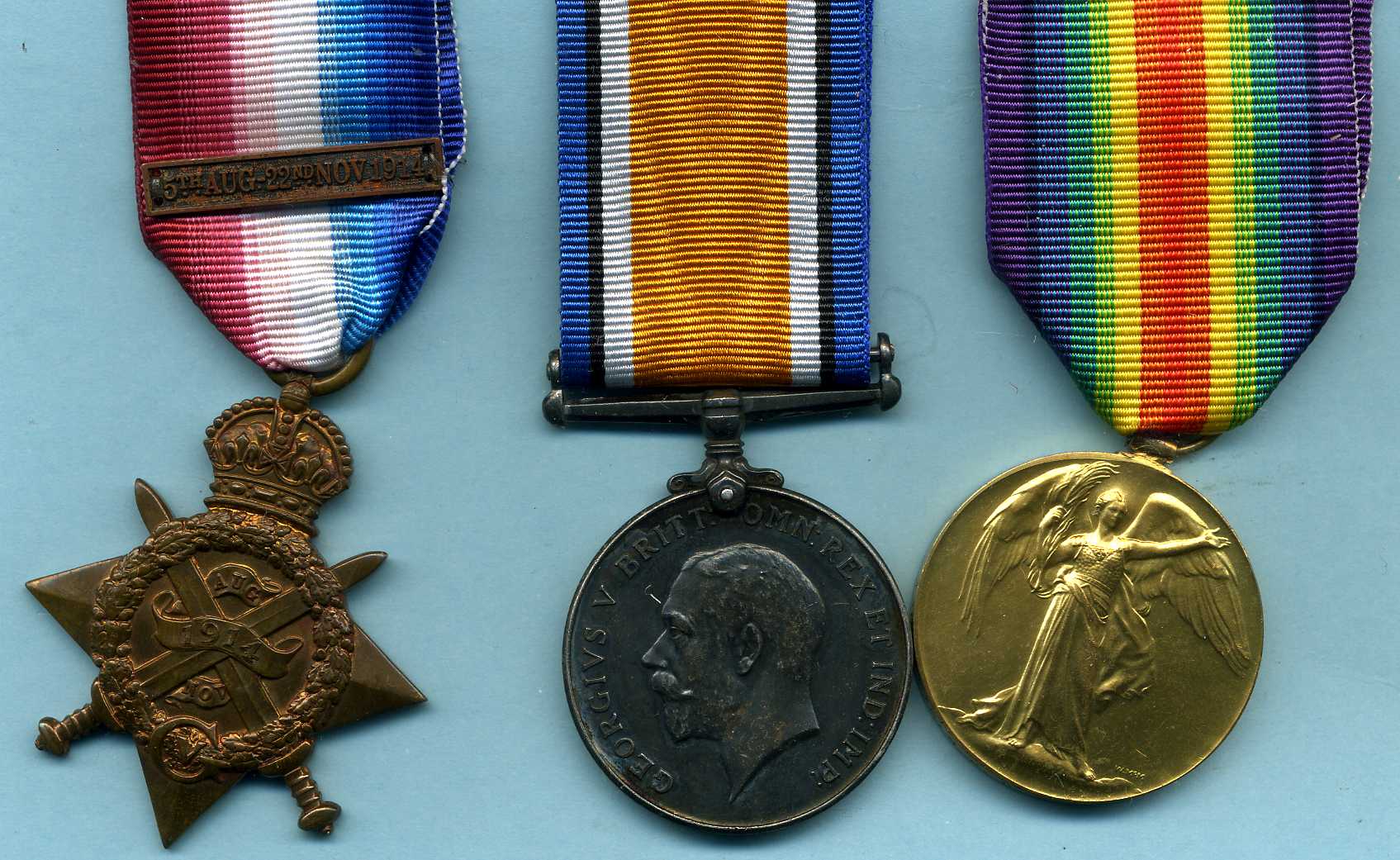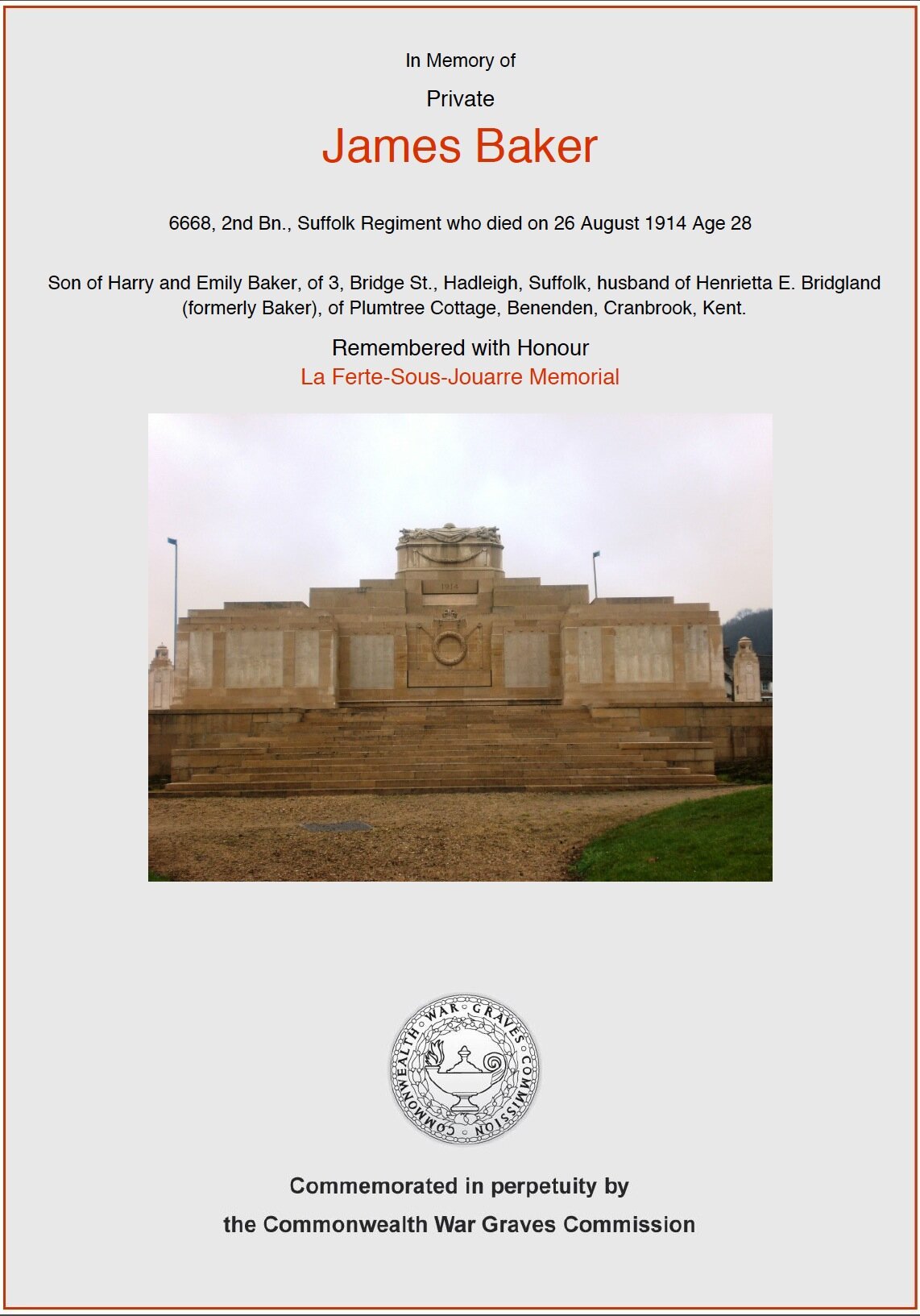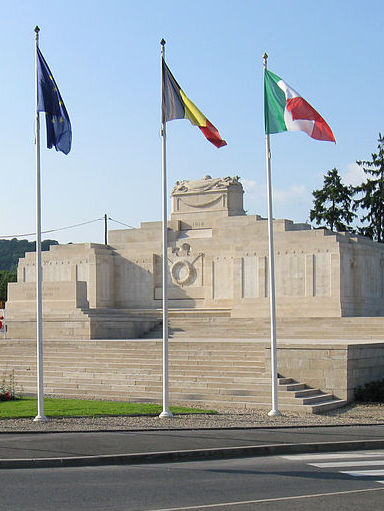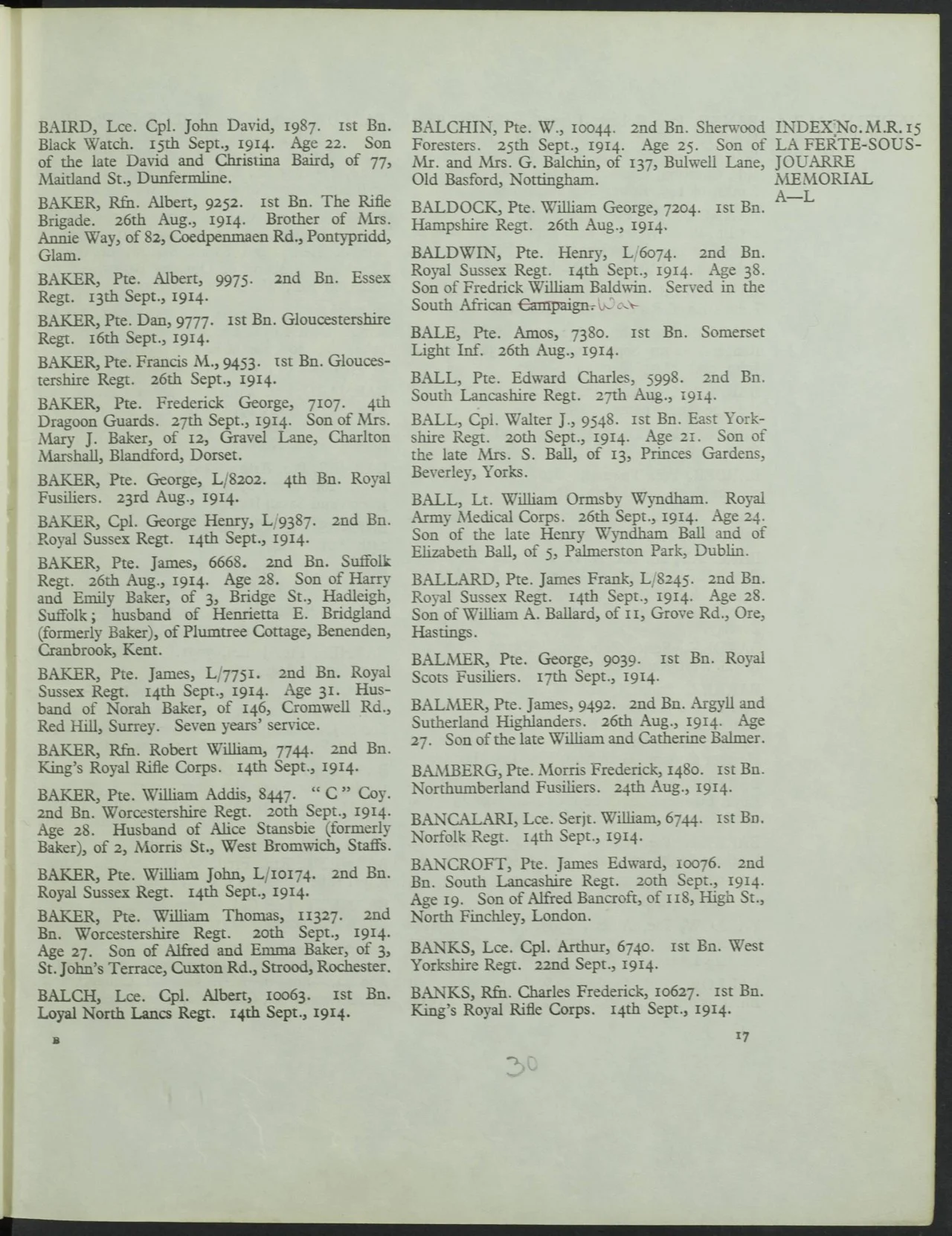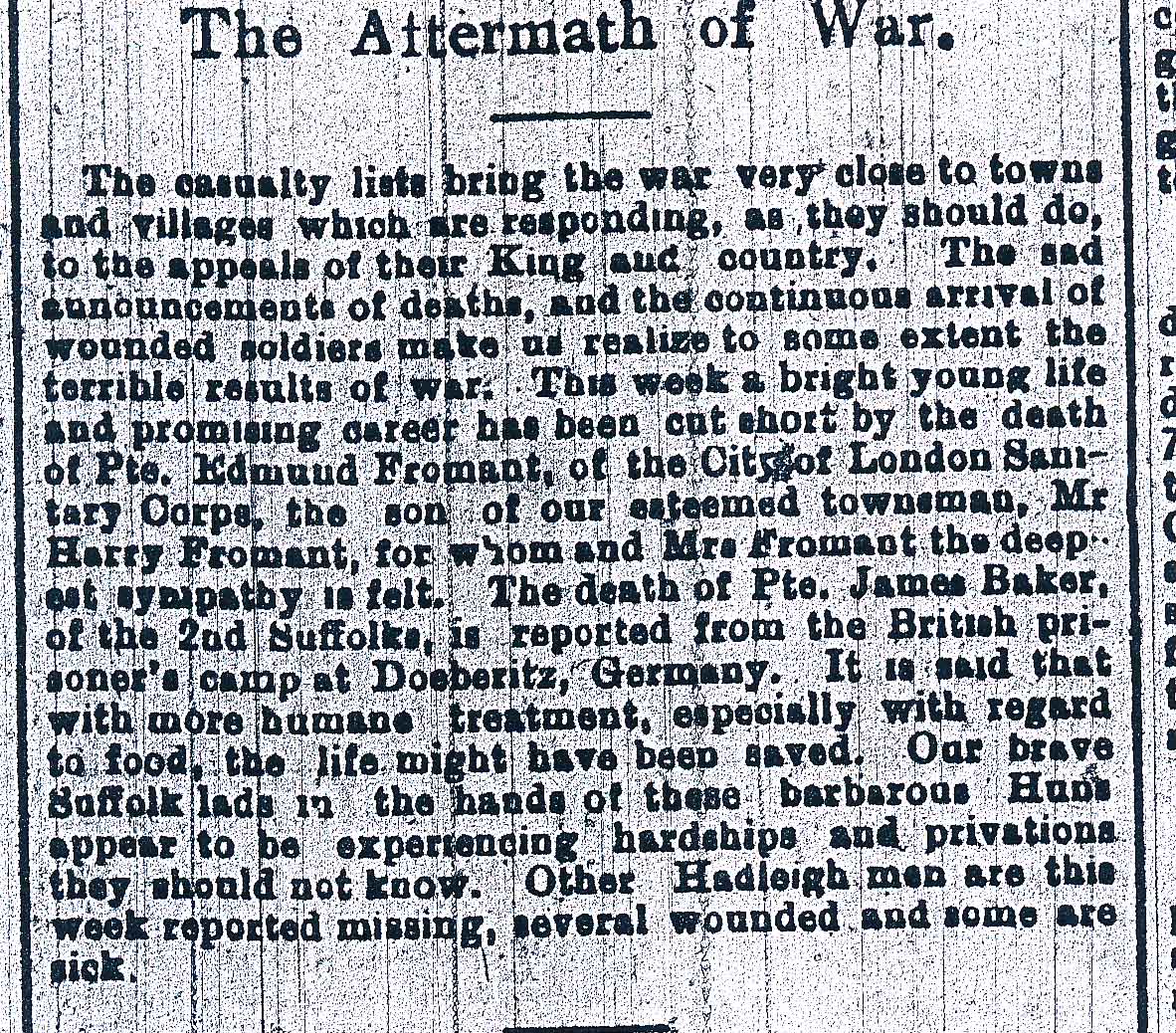James Baker
Rank: Private
Service Number: 6668
Date of Birth: 1885
Regiment: 2 Suffolk Regiment
Date of Death: 26 August 1915
Age at death: 28
Cemetery / Memorial: La Ferte-Sous-Jouarre Memorial
Country: France
Grave / Reference: Panel 9A
Relatives: Son of Harry and Emily Baker of 3 Bridge Street, Hadleigh. Husband of Henrietta E. Bridgland (formerly Baker), of Plumtree Cottage, Benenden, Cranbrook, Kent.
Address: 3 Bridge Street, Hadleigh & Plumtree Cottage, Benenden, Kent.
It is thought that James Baker was born in Little Maplestead, Suffolk in 1886 although the 1911 Census report him as aged 25, living at home at 5 Angel Street, Hadleigh with his parents; Harry (aged 55 a farm labourer) and Emily (aged 57). Also live there was James’ wife of 5 years, Hettie (aged 22 and born in Aldershot) and their son, 8 months old Percy. We later find that James had three children; Rose Ellen (1908), Percival (1910) and ernest George (1913).
Private Baker was entitled to the above three medals; 1914 Star, British War Medal and the British Victory Medal. The whereabouts of Private Baker's actual medals is currently unknown.
The 2nd Battalion Suffolk Regiment was commanded by Lieutenant Colonel C.A.H.Brett DSO. They were part of 14th Brigade, 5th Division and on arrival in France they numbered 28 officers and 971 Other Ranks. They were initially deployed to the defence of the Belgium city of Mons and took up positions on the Mons-Conde canal. But once Mons was outflanked, the Suffolks and the rest of the British Army had to retreat. The Suffolks reached Le Cateau on the 25th August. After bivouacking at the cross-roads west of Le Cateau, they moved to the high ground nearby on the 26th and came under repeated attacks, from infantry, shell fire and machine gun fire. During one bombardment Lieutenant Colonel Brett was mortally wounded. The Germans massed for a final attack at 2.30pm and called upon the Suffolks to surrender. Attacks came from the front and right flanks, but the battalion was only finally overrun when the Germans worked their way round to the rear of the Suffolks positions. The survivors got away to Bohain and mustered for a roll call in St Quentin which only showed 2 Officers and 111 Other Ranks left. The majority of the losses were men who were wounded and taken prisoner; it is estimated that more than 500 men from the battalion became prisoners of war in this action.
It is difficult to know whether the James Baker listed 5th from the top on the PA 358, who is listed as an Infantry solder with a thigh wound in Philosophenweg, Cassel, is actually the Hadleigh James Baker. Clearly, the ICRC thought it was at the time.
But if the ICRC were only going off the names on their lists, then the Baker listed 6th on the list could also be a James Baker. The two dashes, could mean ‘ditto’, i.e. another James. this time an Infantry Private, wounded under his arm and in a field hospital in Le Chateau.
So by the end of 1914 there are two possibilities. Either James was actually killed on the 26th and his body is lost on the battlefield, or he was wounded and taken prisoner and was subsequently being treated in an unknown hospital.
La Ferte-sous-Jouarre Memorial
In the early 1900, James enlisted into the Suffolk Regiment. His Regimental number was 6668 and by referring to the Army Service Numbers Blog, we believe he enlisted in late 1903.
The Army Service numbers blog on its’ page for the Regular Army Battalions of the Suffolk Regiment notes that 6319 was issued on the 6th January 1903 and 6716 was issued on the 4th January 1904.
https://armyservicenumbers.blogspot.com/2009/07/suffolk-regiment-1st-2nd-battalions.html
The norm was to sign up for a period of 12 years. 1903 however was a time of transition for the British Army. The most common form of enlistment up to 1903 was to spend 7 years in uniform under military discipline, (“the colours”) and 5 in the reserves. From 1903 onwards the Army began to push 3 years in the colours and 9 in the reserves. So given the period of enlistment James would have been liable for military service up until 1915. And given either of those likely splits he would be a Reservist in “civvy” street by the time the 1911 Census of England and Wales was taken on the 2nd April 1911.
At the outbreak of the war the two Regular Army Battalions of the Suffolk Regiment were based in Khartoum, (1st) and the Curragh, Ireland, (2nd) while the much smaller training and depot Battalion, (3rd) was based at Bury St Edmunds. Reservists like James were mobilised on the 5th August 1914. He would have been dispatched to Ireland to help bring the 2nd Battalion up to wartime strength. Shortly afterwards they moved to France. James landed there on the 15th August 1914 according to his Medal Index Card.
James Baker Medal Index Card
In the confusion and chaos that followed the battle and without any information as to the actual whereabouts of James, the Army posted him as missing, presumed dead.
In this very early phase of the war, the situation on the ground was rapidly changing and the reporting systems and procedures would have been very chaotic and unreliable. Nevertheless and with no evidence to the contrary, it seems that the official date of James’ ‘presumed’ death becomes fixed on the 26th August 1914 and all subsequent official correspondence uses this date.
The Commonwealth War Graves Commission (CWGC), based on a summary of information originally received from the Army, recorded him as having died, aged 28, on the 26th August 1914. He was the son of Harry and Emily Baker, of 3, Bridge St., Hadleigh, Suffolk, husband of Henrietta E. Bridgland (formerly Baker), of Plumtree Cottage, Benenden, Cranbrook, Kent. He has no known grave and is permanently remembered on the La Ferte-Sous-Jouarre Memorial in France.
The various countries involved in the war provided lists of prisoners to the International Committee of the Red Cross (ICRC) and the ICRC created an index card for each prisoner. While these cards recorded some information they are still very sparse.
With James reported missing, his wife Hettie, made enquiries to the ICRC. An index card (G E 361) exists from H (Hettie) Baker, enquiring about 6668 James Baker of the 2nd Suffolks, missing at Le Cateau on 26/8.
It seems that the ICRC would then check their lists to see if they could locate the individual. The response written on index card G E 361, suggests that they thought that James was listed on PA 358, as a patient in hospital at Philosophenweg, Cassel.
The plot thickens in March 1915 when an article appears in the Essex and Suffolk Free Press. The article relating war news for the town of Hadleigh states that ‘the death of Pte. James Baker, of the 2nd Suffolks, is reported from the British prisoner’s camp at Doeberitz, Germany’. It goes on to say, ‘It is said that with more humane treatment, especially with regard to food. the life might have been saved. Our brave Suffolk lads in the hands of these barbarous Huns appear to be experiencing hardships and privations they should not know’.
This article appears to confirm that James survived the battle of the 26th and ended up on Doeberitz POW camp. Is journey to the camp probably was via hospital after receiving treatment for any wounds. Sadly, it looks like James may have had a relapse and died of illness caused by his wounds.
At that time it is likely that he would have been buried at the camp cemetery although by the time the Commonwealth War Graves Commission arrive to organise the war cemeteries in the early 1920’s there was no record of his burial. His official date of death remains 26 August 1914.


